On the highway to Foremost I came across one of these farms. An abandoned truck parked between a rundown barn and farmhouse set in a field of grass long since mowed or maintained. Beyond, a field looked ready for sowing, but not by any hands that might have worked the land in the past.
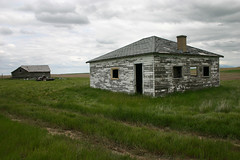
These buildings had a wonderfully weathered look to them. Had I not made the u-turn to go back and take photos I likely still would be kicking myself.
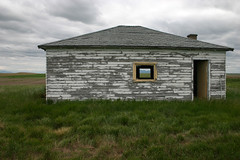
I don't know what function this building once served, but it could have been a small farmhouse. There is something about walking around places like this. I'm not a superstitious person, but it's hard not to think you're rubbing shoulders with ghosts.
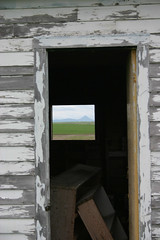
The Sweetwater Hills are framed in the window.
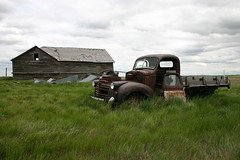
Who knows when it happened, but one day in the past someone parked this truck and never returned to it. Ever. It always strikes me as peculiar to see vehicles abandoned in people's yards.
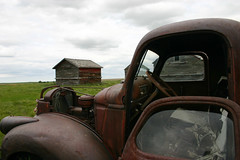
Inside and out the truck showed its age. Something tells me I could return to this spot in a dozen years and not much will have changed.
June 12, 2006
Etzikom and the Etzikom Museum was my next stop. Back at the tourist info centre in Milk River, William suggested I pay a visit to the museum. He had heard good things about it. I wasn't disappointed. I won't get into too many details because it's getting late.
The museum is actually two museums in one. The first thing you notice when you arrive is the field of windmills. Dozens of different styles, including one that was shipped in from Martha's Vineyard. The building itself is a converted school. Inside, the classrooms were each given a theme that reflected an aspect of homesteader life in the area. The museum was about the homesteaders and was supported by descendants of homesteaders. It was an unexpected surprise and a real delight.
William was a good man to point me toward the Museum in Etzikom. He had not visited it himself, but was emphatic that he had heard only good things about it. People who know a thing or two about museums, he said, had told him it was a standout place. How could I resist?
When I parked the car it was the only one in the lot. The first thing to capture my attention was the field of windmills behind the old '50's style, single story, former school that housed the museum. The loose collection of windmills marks the grandly titled Canadian National Historic Windpower Centre. Not to minimize the historical significance of the pieces here, it resembled a rather large mini-golf course, asphalt trails and all. The windmills, with the exception of the largest one, were representative of what would have been used on the prairies over the last century. The largest one looked more like a Dutch style windmill and was shipped to the museum in pieces from Martha's Vineyard.

Canadian National Historic Windpower Centre
Etzikom has a population of about 60 and the re-purposing of the school is again a reflection of the migration of people away from rural areas. There just aren't enough young people in the area to justify the community having its own school. The lobby of the building is now the museum's cafe. It's styled a little after an old country diner, with a bar and stools and where you can get a shake or piece of fresh-baked pie. It was starting to feel a little hokey, and I wasn't sure if I'd pay the $4 entry fee to get a gander at the whole thing. But, the woman who was working the museum spoke so enthusiastically about what lay just beyond the cash-jar, where entry fees went, I parted with $5 and headed right in. What a treat.
Each of the school's classrooms was assigned a theme, and dioramas were built to reflect what life might have looked like for the average homesteaders in the early part of the 1900's. There was a streetscape with a general store, a hotel, post office and carriage. I'm not an expert on the period being depicted, but I was impressed with the details.
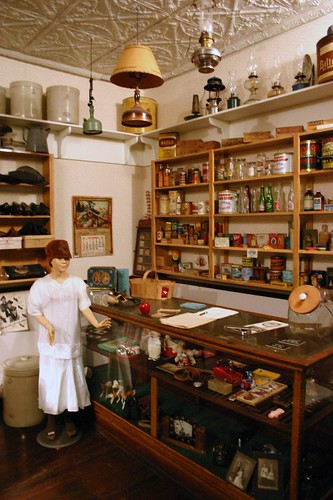
Inside the General Store.
I spent an hour wandering from room to room, taking it all in. There was a clothing room, with clothes and toys from the period, and a music room filled with pianos, player pianos and artifacts from music playing of yore, including paper rolls for the player pianos, 72 and 33 rpm records, and music books for entertaining the family. The wildlife and Natural History room was a bit creepy, but that's only because I find large collections of dusty, old, dead stuffed animals just not totally right. Some of the taxidermy left something to be desired.
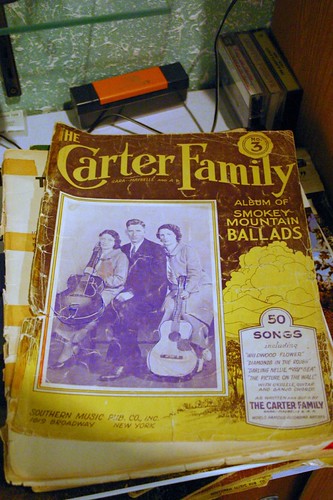
Yay, the Carter Family Album of Smokey Mountain Ballads.
The Homesteader room was the most fascinating room in the museum. A kitchen, parlour and bedroom all stocked in the quaint manner typical of the period. The detail was quite remarkable and it left me feeling pretty good about many of the modern conveniences available to me. Now that I think about it, the picture isn't complete without a detailed diorama of where homesteaders went to, ahem, relieve themselves. No doubt nothing quaint about that.

Would they really have had a portrait of the Queen on the wall?
Raylene, the woman who had coaxed me into the museum, was always at hand, ready with answers to my questions. I wasn't trying to stump her or anything, but in hindsight I wish I had, because her knowledge of the museum and the area seemed complete. She was like the knowledge god of Etzikom.
She also coaxed a piece of fresh apple pie down my throat. The pie was delicious and I challenge anyone to find a place that serves even mass produced pie for $2.50 a slice. yummy. Raylene said some money for running the museum comes from the provincial and federal governments, but that a lot of the money has come from donations. The wall behind the museum cafe's counter is filled with plaques noting donations made by locals, many of whom are descendants of homesteaders. In those cases the date and location of the homestead is included on the plaque.

Every issue of National Geographic dated between 1924 and 1996 is on the shelf of the Etzikom Museum library. To everyone who passes through, Raylene, one of the museum's staff, suggests they take a look at the copy dated the month of their birth.
After my long and unanticipated visit to the Etzikom Museum I realized every little town has a story to tell. Etzikom's story is that of the settling of the prairies and of the homesteaders. It preserves a glimpse at a way of life hard to imagine 100 years later. There will be other tales, in other towns, and I have to remember to take the time to listen and observe those tales when the cross my path.
1 comment:
Thank you for visiting the museum and writing about Etzikom. My mother grew up there, and my Grandpa still lives there. It is a beautiful area of Alberta, and one that is very much off the radar.
Post a Comment